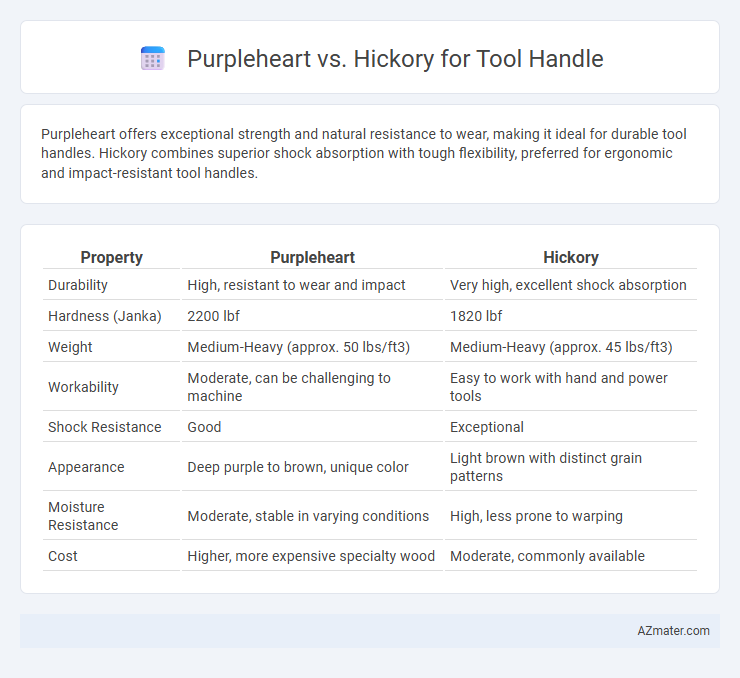Purpleheart offers exceptional strength and natural resistance to wear, making it ideal for durable tool handles. Hickory combines superior shock absorption with tough flexibility, preferred for ergonomic and impact-resistant tool handles.
Table of Comparison
| Property | Purpleheart | Hickory |
|---|---|---|
| Durability | High, resistant to wear and impact | Very high, excellent shock absorption |
| Hardness (Janka) | 2200 lbf | 1820 lbf |
| Weight | Medium-Heavy (approx. 50 lbs/ft3) | Medium-Heavy (approx. 45 lbs/ft3) |
| Workability | Moderate, can be challenging to machine | Easy to work with hand and power tools |
| Shock Resistance | Good | Exceptional |
| Appearance | Deep purple to brown, unique color | Light brown with distinct grain patterns |
| Moisture Resistance | Moderate, stable in varying conditions | High, less prone to warping |
| Cost | Higher, more expensive specialty wood | Moderate, commonly available |
Introduction: Purpleheart vs Hickory for Tool Handles
Purpleheart and Hickory are both popular choices for tool handles due to their durability and strength. Purpleheart offers exceptional hardness and resistance to wear, making it ideal for heavy-duty applications, while Hickory is known for its shock absorption and flexibility, providing user comfort during extended use. Choosing between Purpleheart and Hickory depends on the specific tool requirements and the balance between toughness and ergonomics desired.
Overview of Purpleheart Wood
Purpleheart wood, known for its striking deep purple hue, offers exceptional durability and resistance to wear, making it a top choice for tool handles that require long-lasting strength. This dense hardwood delivers excellent shock resistance and a smooth finish, enhancing grip and comfort during extended use. Compared to Hickory, Purpleheart provides superior hardness and distinct aesthetic appeal, ideal for specialized tools demanding both functionality and visual uniqueness.
Overview of Hickory Wood
Hickory wood is renowned for its exceptional toughness and shock resistance, making it a preferred choice for tool handles that require durability and impact absorption. Its dense grain structure provides a comfortable grip and resists wear, enhancing tool longevity under heavy use. Compared to Purpleheart, Hickory offers superior flexibility and resilience, key attributes for high-performance handles.
Durability and Strength Comparison
Purpleheart wood exhibits exceptional durability and strength, making it highly resistant to wear and impact, ideal for tool handles subjected to heavy use. Hickory is renowned for its toughness and shock resistance, often preferred for its ability to absorb impact without cracking or splintering. In direct comparison, Purpleheart offers higher hardness and long-term durability, while Hickory provides superior flexibility and resilience under repeated stress.
Shock Absorption and Flexibility
Purpleheart offers superior shock absorption for tool handles due to its dense, close-grained structure that minimizes vibrations during use. Hickory is known for exceptional flexibility and toughness, allowing it to withstand repeated bending without breaking, which enhances durability under impact stresses. For tool handles requiring a balance of shock reduction and flexibility, Purpleheart provides better vibration dampening, while Hickory excels in flexibility and resilience.
Workability and Ease of Shaping
Purpleheart exhibits moderate workability with a fine, straight grain that allows for smooth shaping but requires sharp tools due to its density. Hickory offers superior ease of shaping and excellent shock resistance, making it a preferred choice for tool handles needing durability and comfort. Both woods respond well to sanding and finishing, but Hickory's elasticity often results in less fatigue during prolonged use.
Resistance to Moisture and Weathering
Purpleheart wood exhibits excellent resistance to moisture and weathering due to its natural oils and dense grain structure, making it highly durable for outdoor tool handles. Hickory, while exceptionally tough and shock-resistant, is more susceptible to moisture absorption and requires regular sealing to prevent weather-related damage. Choosing Purpleheart ensures longer-lasting tool handles in damp or variable weather conditions without frequent maintenance.
Weight and Balance in Tool Handles
Purpleheart, known for its dense and heavy nature with a specific gravity around 0.8 to 0.9, offers substantial weight that enhances stability and reduces vibration in tool handles. Hickory, lighter with a specific gravity near 0.7, provides excellent shock absorption and a more responsive balance ideal for dynamic tool control. The choice between Purpleheart and Hickory hinges on desired tool performance, where Purpleheart delivers solid heft and stability, while Hickory offers lighter handling and enhanced tactile feedback.
Cost and Availability
Purpleheart is generally more expensive and less readily available than Hickory due to its exotic origin and slower growth rate, making it a premium choice for tool handles. Hickory, widely grown in North America, offers excellent shock absorption and durability at a significantly lower cost and with easier procurement. For budget-conscious projects requiring high strength, Hickory remains the preferred option, while Purpleheart caters to those seeking unique aesthetics despite higher price and limited availability.
Best Applications and Final Recommendations
Purpleheart offers exceptional durability, resistance to wear, and a smooth finish, making it ideal for high-impact tool handles such as hammers and mallets that require strength and shock absorption. Hickory provides excellent shock resistance and flexibility, favored for tool handles like axes and shovels where a balance of toughness and resilience is crucial. For applications demanding maximum toughness and long-term durability, Purpleheart is recommended, while Hickory is preferred for tools needing superior shock absorption and flexibility.

Infographic: Purpleheart vs Hickory for Tool Handle
 azmater.com
azmater.com